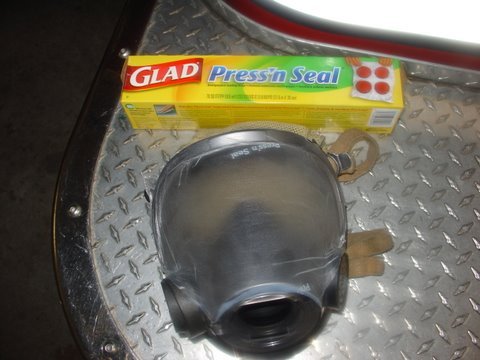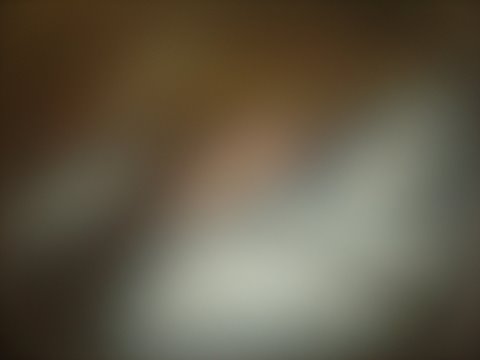Here’s a quick and cheap way to “smoke up†someone’s mask for training. Firefighter Jason Zamarron from Grand Rapids Fire sent in this great idea. He took some Glad Press-N-Seal cut it to size and stuck it on the outside of the mask. As you can see in the second picture it gives a somewhat distorted smoke type of view. If a more obscured view is desired, a second piece can be placed over the first. One great feature about this method is that it can be taken off the mask quickly when a call comes in. This idea works well when the entire room can’t be smoked up due to time, logistics, or any other reason. It will be added to the Tips from the Bucket page.



I’ll have to give that a try. It seems like an interesting improvement over wax-paper inside the mask.
I have always been used to using the “original” wax paper inside of the mask. This method was never very efficient in that the wax paper would always be sliding around and most of the time, end up not doing its job. This is a better idea. We need to “keep these ideas fresh”.
Also works if you are too cheap to buy alcohol and wear glasses.
Fella’s,
I have always used a Coffee filter inside my mask. It works well. Very easy to remove. Take care and stay safe…
Put your hood on backwards to cover your mask.
It’s free.
Great idea! Becareful using your hood, It could stretch.
Stay Safe!
We have used this method in many RIT and search drills in our department. Works excellent!!!! Just be sure to clean the lens immediately after you remove the press-n-seal because it leaves a residue that once it dries it’s a pain to remove.
While turning your hood around does work to some extent the reason many have turned to using the wax-paper or this type of method is the hood is not either properly being worn or is an extra put over the head. This changes how you normally wear your PPE or adds another layer you don’t normally wear. When instructing students we usually try to ingrain a set of behaviors, the order of steps in a process or putting tools/equipment in certain pockets. Changing something from the means you operate by or have trained in means the greater chance of confusion when placed under stress. Under stress we all revert back to learned and ingrained behaviors, we don’t exhibit new behaviors. Therefore I like the idea of having students/FFs in a training session outfitted in their PPE as they would on a job. By just covering the facepiece (for under $5 a roll)the rest of the student’s/FF’s PPE is as it will be on a job. If a student has to activate their bypass valve I want them to go directly to it in training, not having to reach up under a hood. Like most things in training it needs to be “Train the way you fight. Fight the way you train”. And finally it’s just too easy for someone to look through the hood or out the bottom. Just my usual $0.02.
I personally do not like the use of the hood as “smoke”. This tends to get very bulky and does not allow you to properly secure your helmet. Not only is it bulky but it can be a real problem in an emergency. I find it to be difficult getting the hood back off because of the regulator and everything else. These gadgets allow it to hang up easily and if a firefighter becomes distressed it can be difficult to remove in an emergency. If a trainee becomes paniced with the press n’ seal you can simply remove it. As a personal preference I don’t like the hood method.
In my station we use a black plastic trashbag, cut to the size of the face peice lens and use a rubber band to secure it around the lens (where your hood sits around the mask). Just my two cents! Be safe!
I would not ask the students to turn their hood around anymore than ask them to put their boots on the wrong feet. This does nothing but make them complacent, we need to enforce proper wearing of all protective clothing from day one, when they reach for their hood, it only goes on one way, and it is not stretched out either.
We have created from rubber tire tubes cut outs that actually stretch over the mask and slide over the exhalation valves, also have different color transparency film that covers the mask to divert natural lighting.
This is an awesome idea. Ill let my Lt know if he doesnt already.
I like the ideas guys. Remember, in the fire service there is a thousand ways to do something and thats just another fresh idea. the view reminds me of the last quarter of the Patriots AFC championship game I went to last week!!
Great idea.. and Ray is correct, a thousand ways to do something (or at least a dozen in this case)..
What I like about this idea, you get some light but can not clearly make out objects. When you use a black garbage bag or a hood, you get no light at all.
Different situations, different training, needs different mask blockers…
Stay safe!
Not the forum for it but, I don’t see where “complacent” attitudes develop from having a student wear his hood backwards during a mask confidence drill??? Complacency would be when the student feels he does not need to do the drill.
Point is, you can go to any vacant building, drill ground, or on the apparatus floor and have an instant black out scenario by using the hood turned backward.
Not trying to spark an OSHA-101 arguement.
Great website.
Stay Safe all.
That’s a great idea. At my FD we use old overexposed X-ray film that doctor’s offices get rid of. It is dark black and cut to pattern that fits nicely inside your mask. It is sturdy enough not fall out but flexible enough to be removed quickly.
have used the press-and-seal at the volly house. It works great, but seems to leave a residue that is very difficult to remove.
I just used that idea tonight and I agree with cherry516 it did leave a residue on the masks. It worked wonderfully in simulating smoke maybe we will try it on older masks not used anymore.
I have found a product that is relatively inexpensive and works great in RIT and S&R training. It is called “Smoke Trainer.” The material is similar to the x-ray film, but comes in 3 different obscurities. The light and medium obscurity also allows the use of a Thermal Imaging Camera. These are designed to be an exact fit inside the mask of many different manufacturers. They insert and remove easily. Check them out at smoketrainer.com.
We had a recent SCBA training after seeing the Press’n Seal tip here.
Tried it and liked it. Good for cheap, and maybe lazy, departments who don’t have or can’t access a smoke machine.
Less cleanup than using a smoke machine.
We tried cutting the Seal to a little than larger lens fit. But after a couple masks went with having someone slap on a square section onto the lens before you put the hood onto your mask.
With the lights out and helmet and coat lights on, gave a murky smoked look.
Practiced following hose couplings and tangled different colored hoses. Also stressed checking air gauge and facemask indicators. The meters were readable if the gauge was almost placed right onto the facemask lens. The facemask indicators were fuzzy depending on how bunched the Seal was between regulator and lens.
It was good learning the difference obstructed vision has on air usage when crawling by feel. Went slower, took more time and used more air.
Will also try using black plastic.
Using the Seal is better than the turned around hood due to less hood stretch, realistic donning of gear and fit.
Tried the idea. Worked fantastic. Thanks for the tip. Allowed the firefighters to use their flashlights but they could only make out the outline of the shapes, if they got close enough they could almost tell what it was. It was perfect.
I’ve used it twice for teching scba confidence and search & rescue. Yes it is cheaper to use your hood, but it does give the student a better feel for what it is to work in smoke. I will use it every time for now on. Thanks for sharing.
What I have personally found that works is using wax paper. The trick is to crumble it up first, then spread it out in the mask. I have found in the past by putting something on the outside of the lens, it usually has a tendancy to get dislodged in entanglement simulators, etc. Just a thought.
Thanks for the idea. We used the backwards Nomex previously, and I never really cared for it. We ran a search drill for a Probie the other day and I decided to try this. It works great, and only cost me $2.89, not to mention that we’ll get several uses from one roll. I felt that it took two layers to really obscure the mask. No more backwards hoods for us.
Any ideas on how to remove the residue it tends to leave? I’m having a heck of getting it off a SCOTT Av3000 mask
Thanks
We found that an alcohol prep works well. It may take a little work, but it will come off. After the prep, make sure you rinse with water. We don’t want to find out the hard way that the alcohol may damage the mask. It’s wierd, all of our masks are the same but only some left residue. -Jimm-
We have used this a number of times now at our training center to slowly bring the new guys into working with no vision. It works very well. We haven’t noticed the residue issues, at least not that anyone has brought to our attention. We have the foam inserts at my firehouse, they work pretty well also until you get them after the guy that was really sweating!
Check out the Eclipse Blackout Masks!
Eclipsefgs.com